Abstract
The combination of brain cells and artificial intelligence (AI) is a paradigm shift in the healthcare industry that provides previously unheard-of chances for creativity and change in a variety of fields. This work is an attempt to offer a thorough examination of the confluence of AI and brain cells in healthcare, clarifying important ideas, methods, and applications that will influence medical practice and research going forward. Theis article provides an overview of AI in healthcare and looks at the wide variety of AI methods and algorithms advancing personalized medicine, therapy optimization, and disease diagnostics. It also touches upon how AI and brain cells interact, and how brain–computer interfaces (BCIs) can transform neuroscience research and human–machine interaction. It also highlights the revolutionary influence of brain cells and AI on healthcare delivery and patient care by outlining the application domains of the BCI across research fields and talking about the integration of reinforcement learning with the BCIs. It also showcases the practical applications of brain cells and AI in healthcare, ranging from prognostication and diagnostics to prosthetics and rehabilitation. This work suggests new trends and research and development opportunities in the field of brain cells and AI integration, as well as future directions in this field.
1 Introduction
A revolutionary phase of healthcare technology has emerged from the convergence of neuroscience, artificial intelligence (AI) [1], and healthcare. A novel frontier in advanced healthcare applications is the merging of AI with brain cells. The diagnosis, treatment, and comprehension of neurological illnesses and cognitive processes could be greatly improved by the combination of technology and neuroscience. Researchers and physicians are investigating new paths for personalized medicine, brain–computer interfaces (BCIs), and the creation of novel medicines by combining the computational power of AI with the intricate workings of brain cells. This combination of fields not only provides previously unheard-of insights into the workings of the brain but also creates new avenues for innovative medical practices that could greatly improve patient treatment and standard of life.
This article examines the dynamic field of brain cell [2] utilization in healthcare through the application of AI techniques. Recent developments in AI and neuroscience [3] have combined to change healthcare practice. This work attempts to clarify the potential applications of brain-cell-inspired technologies through current research, and emerging trends. This article’s scope encompasses a broad range of healthcare areas, such as personalized medicine, rehabilitation, prosthetics, disease diagnosis, and therapy optimization. This work aims to shed light on how brain cells and AI can work together to address current healthcare difficulties and enhance patient outcomes. Figure 1 presents the taxonomy of the work.
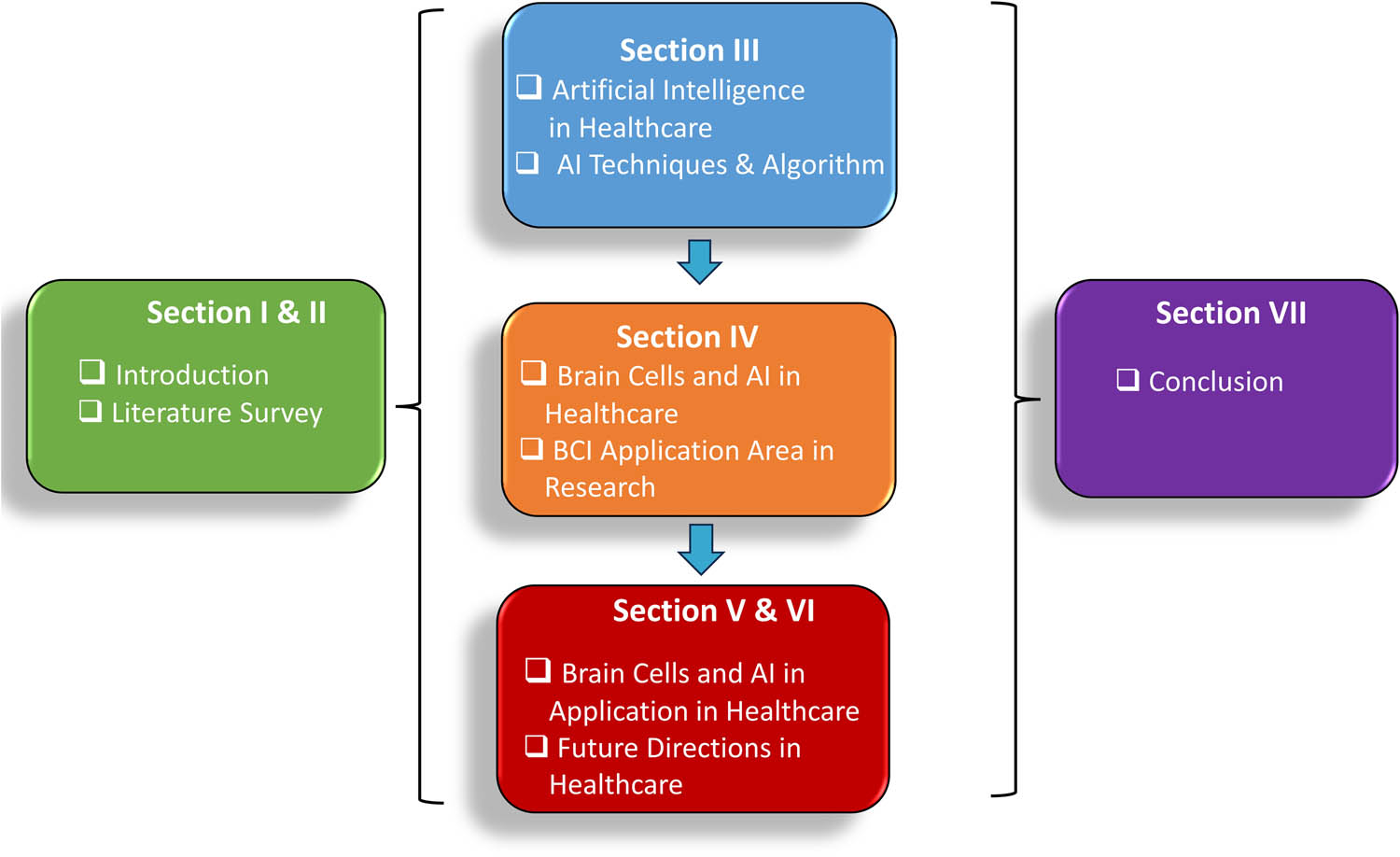
Taxonomy of the work.
This article examines the exciting intersection of AI and brain cell research in healthcare. To ensure a clear understanding, the work is meticulously divided into sections. First, this article establishes a foundation by summarizing current AI and brain cell procedures used in healthcare. Section 3 then dives deeper by examining the applications, methods, and challenges associated with AI in this domain. Next, Section 4 explores the fascinating relationship between AI and brain cells in healthcare; it also highlights concepts like BCIs as well as neural network models. Building on this knowledge, Section 5 showcases specific applications of this powerful combination, which focuses on areas, such as illness diagnosis, treatment planning, and rehabilitation efforts. Finally, this article concludes by outlining the existing challenges and explores promising future directions in the rapidly evolving field of AI and Brain cells for smart healthcare.
2 Existing approaches in the field of BCI and AI
Karikari and Koshechkin [4] explore recent BCI advancements and their prospects in healthcare, gaming, entertainment, and virtual reality. It addresses ethical concerns, technological issues, and legislative frameworks, aiming to stimulate innovation and envision future possibilities. Hong et al. [5] proposed a method that improves recognition rate on a publicly available dataset, potentially improving communication and status monitoring for paralyzed patients in smart healthcare. Blankertz et al. [6] explore the development of brain–computer interactions, focusing on their applications in communication and neurorehabilitation. It highlights the need for further research and development, with a particular emphasis on BCI-based devices for individuals with limited mobility, it also discusses prospects, ethical considerations, and user acceptance of BCI, highlighting their potential for improved quality of life and societal advancement. Varone et al. [3] compare five TL-CNN models for distinguishing motor imagery from finger movements (Mex) using unsupervised electroencepalogram data. A novel probability fusion technique is developed, outperforming other methods. The approach achieves 97.9% accuracy, 93.4% precision, 95% recall, and an F1-score of 93.2%, demonstrating potential for future real-time BCI systems. Jaber et al. [2] highlight AI and BCI are transforming brain–machine interaction, enhancing motor control, sensory feedback, and research. AI optimizes signal processing and control algorithms, enabling disability empowerment, performance enhancement, and deeper brain insights. Challenges include quicker training and improved sensor accuracy. Parui et al. [7] explore healthcare system improvement through BCI and Internet of Things collaboration for smart systems. The visual P300 potential is suitable for controlling smart homes via brain compute intelligence spellers. In a real smart home scenario, users with neuro-degenerative illnesses and normal people experienced high accuracy, indicating IoT speed is sufficient.
3 AI in healthcare
The healthcare sector is at the forefront of process innovation and the adoption of new technologies. Similarly, significant advancements in AI have been made in recent years [8]. MedTech companies, startups, and pharmaceutical and biotechnological companies are currently concentrating on providing cutting-edge AI technology in areas like early diagnosis and detection tools, preclinical studies, clinical trials, genome research, and patient monitoring. Along with patient management, cybersecurity, surgery performed by robots, and fraud detection, significant advances in AI are also being achieved in these areas. The present COVID-19 pandemic has also accelerated the usage of AI-based medical technologies, and in the years to come, this trend is likely to continue. The rapidly changing world, aging populations, and public health crises are putting pressure on healthcare providers to deliver better care, reduce costs, and apply new drug therapies. Leveraging healthcare datasets and AI and machine learning methods can improve healthcare delivery. The health technology sector is expected to reach $280 billion by 2021 [9].
Here are some instances of how AI can be applied to modernize healthcare:
Patient community risk classification;
Predictions and analytics for medication adherence (behaviour);
Propensity for disease predictive analytics;
Hospital-acquired illnesses posed a concern to the patient;
Clinical pathway predictions for safety analytics;
Treatment effectiveness: optimization insights;
Propensity for error (clinical or pharmaceutical);
Predicting the infection rate expansion (similar to COVID);
Predicting the infection rate growth;
Knowledgeable medical practice assembling;
Robotic surgery;
Conscientiousness analytics and monitoring of health;
Cobots: domestic helpers; and
Processing of claims, clinical documentation, revenue cycle control, and administration of medical records.
3.1 AI techniques and algorithms in healthcare
AI technology and algorithms are revolutionizing existing procedures in the healthcare industry and opening up new avenues for diagnosis, treatment, and patient care [10]. Figure 2 illustrates the AI techniques and different algorithms in the healthcare sector.
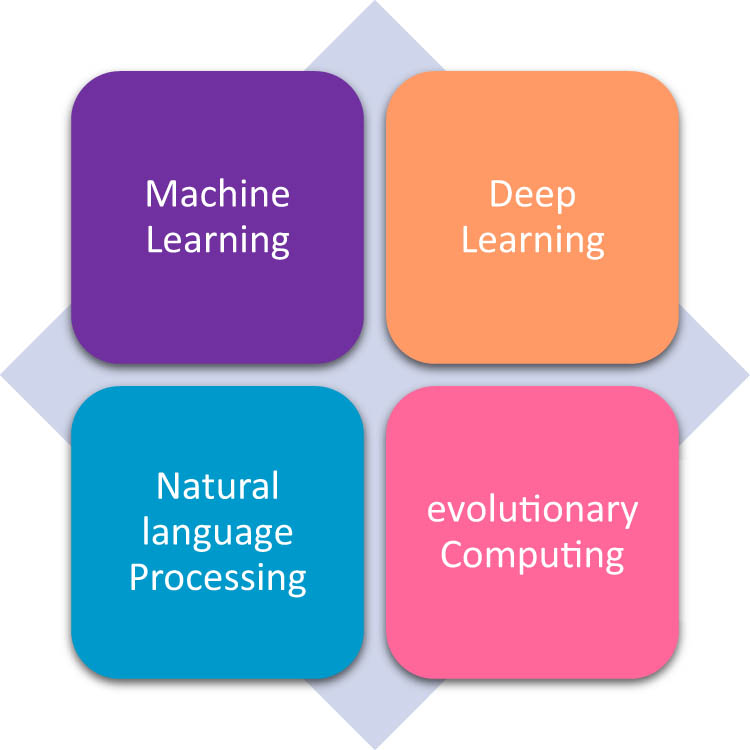
AI techniques and algorithms in healthcare.
The following are some essential AI methods and algorithms frequently used in the medical field.
3.1.1 Machine learning
Healthcare organizations can analyze enormous volumes of data and derive insightful knowledge for better patient care thanks to machine learning techniques. Supervised learning involves training algorithms on labeled datasets so they can correctly classify medical images, identify illnesses, and forecast how well a treatment will work. Finding hidden patterns and correlations in patient data is made possible by unsupervised learning approaches, which makes it easier to complete tasks like patient clustering for personalized treatment and anomaly detection for early illness diagnosis. However, to make sequential decisions, reinforcement learning (RL) algorithms learn from interactions with the environment [11]. This allows them to help with dynamic treatment planning and optimization depending on patient responses and feedback.
3.1.2 Deep learning
Convolutional neural networks, in particular, are deep learning algorithms that have revolutionized medical image analysis by automating identifying and segmenting abnormalities in pictures from computed tomography scans, magnetic resonance images, and X-rays. Because of their superior ability to interpret sequential data, recurrent neural networks are a vital tool for tracking the course of diseases, anticipating patient health outcomes, and spotting possible negative events. Recent developments in deep learning, known as transformers, have shown promise in healthcare natural language processing tasks. These tasks include the study of patient notes, clinical documentation, and electronic health records [12] to extract useful information for clinical decision-making.
3.1.3 Natural language processing
Healthcare systems can now extract useful data from unstructured clinical literature, including patient notes, medical reports, and research publications, thanks to natural language processing [13] approaches. Named entity recognition algorithms are used to identify and categorize entities from textual data, such as ailments, drugs, and symptoms. This technology makes activities like pharmacovigilance and clinical coding easier. Clinical papers are categorized by text classification algorithms according to their content, which facilitates information retrieval, sentiment analysis, and automated summaries. To support tasks such as report production, educational materials for patients, and clinical decision support, language generation models produce content that is coherent and contextually appropriate.
3.1.4 Genetic algorithm and evolutionary computing
Treatment plans and healthcare interventions are optimized by genetic algorithms and evolutionary computation techniques taking into account patient preferences, environmental circumstances, and genetic profiles [14]. By customizing treatment plans and drug schedules to each patient’s unique traits, these genetic data analysis approaches help personalized medicine maximize therapeutic efficacy and minimize unpleasant responses. Genetic variations that affect drug metabolism and response are found using pharmacogenomic applications of genetic algorithms, which help choose medications and alter dosages for the best possible patient results.
4 Interface of brain cells and AI in healthcare
A device that converts neural data into commands that may operate external software or hardware is known as a brain–machine interface, or BMI. It looks like the futuristic device that would allow people to read each other’s minds and communicate through brain waves is getting closer to becoming a reality. Machine learning, signal processing, and neuroscience contribute to the development of BCIs. Brain signal recordings are frequently made using functional near functional infrared spectroscopy (fNIRS). A non-invasive method for recording brain signals is called functional neural imaging radiography (fNIRS) [15]. Through the use of an interactive learning technique called RL, systems can learn to interact with their surroundings and receive rewards. The algorithm itself is meant to adapt by utilizing a feedback signal.
4.1 An overview of BCI
The human BCI devices use brain activity to translate human cognitive patterns. According to Figure 3, they can manage a wheelchair or robot by using recorded brain activity to interact with a computer in a way that is consistent with human objectives when it comes to external devices or environments [16].
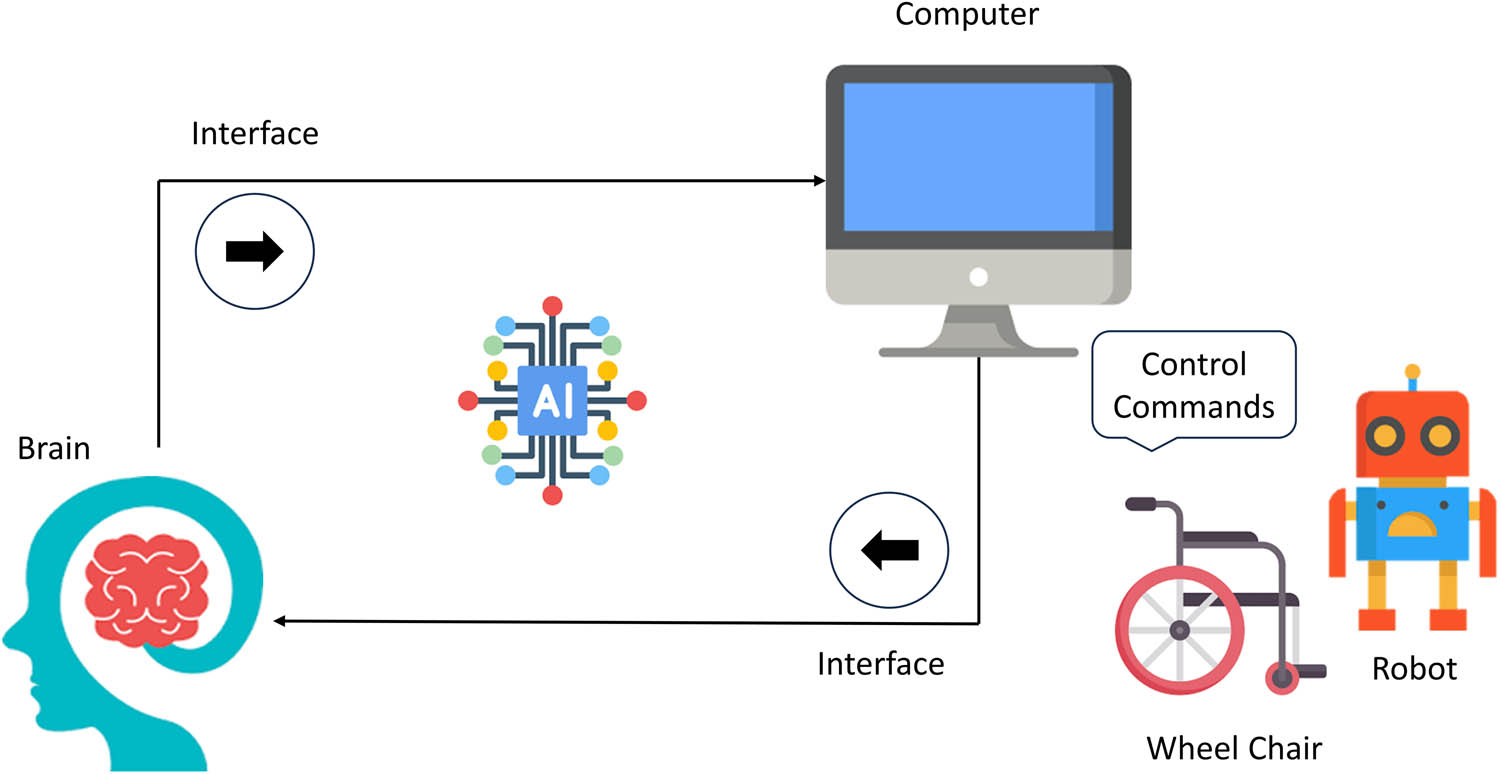
BCI framework.
BCIs fall under two main categories. BCIs of the first kind are reactive and active. An active BCI uses patterns in brain activity that the user directly and consciously controls to operate a device, regardless of what happens outside the device [5]. Reactive BCI harvests brain activity responses to environmental stimuli, which are then indirectly controlled by the user to operate a device. Passive BCI, which aims to enhance human–computer interaction by exploring users’ perception, awareness, and cognition without requiring voluntary control, is the second class of BCI [17].
4.2 Application area of BCI in research fields
BCIs, or BCI, have become extremely potent instruments with a wide range of applications in many scientific domains, revolutionizing both human–computer interaction and our comprehension of cognitive processes. By enabling simple control mechanisms, the BCI improves user experience and immersion in the world of game engagement by enabling users to interact with gaming interfaces using neural signals and navigate virtual landscapes [18]. When it comes to robot control, the computer interface makes it easier for people to communicate with machines and enables them to operate robotic equipment and carry out intricate tasks using brain signals. Additionally, BCIs give researchers a unique perspective on emotional states, degrees of exhaustion, and sleep quality, giving them access to vital information about human behavior, mental health, and overall well-being. BCIs are essential tools for monitoring neurological conditions, assessing cognitive function, and determining the effectiveness of treatment treatments in clinical trials. They provide non-invasive techniques for objective measurement and analysis. As BCI technology develops further, more study fields will find uses for it. This will spur multidisciplinary collaboration, drive innovation, and open up new avenues for neuroscience and human–machine interaction studies. Figure 4 highlights the various applications of BCI in the current research fields.
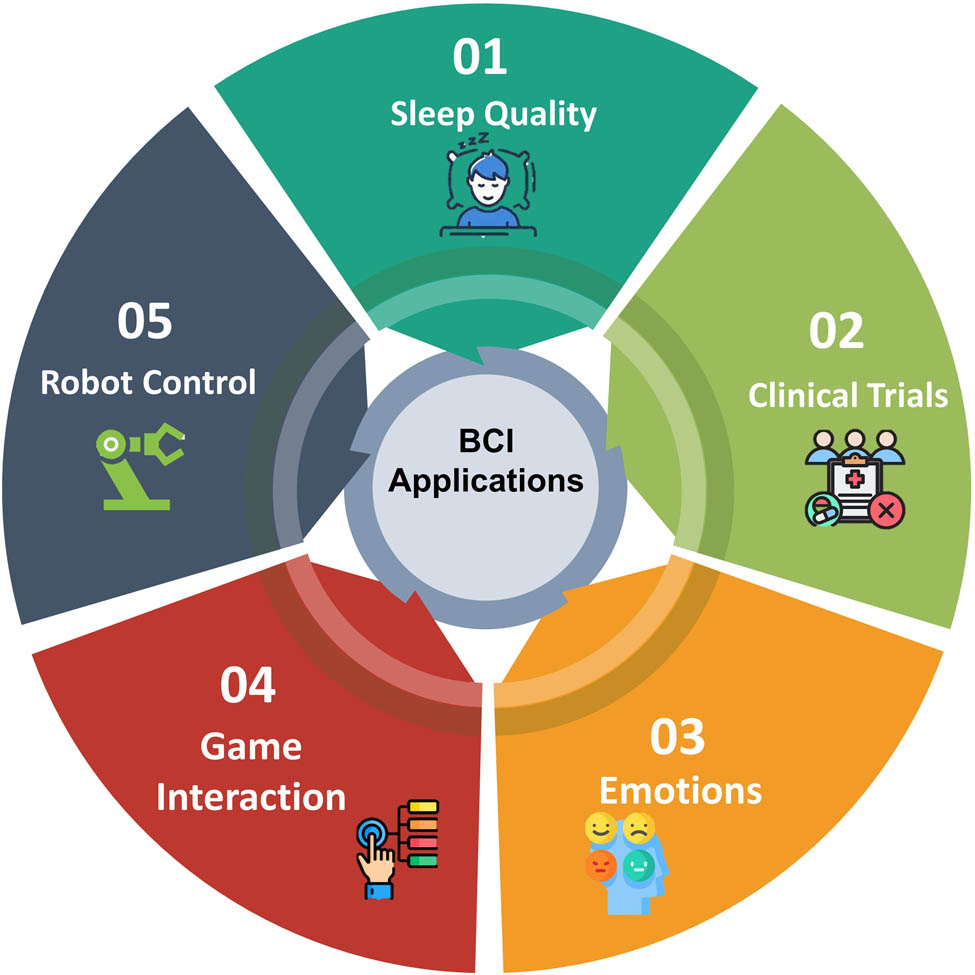
Application of BCI in multiple fields of research.
4.3 RL and BCI
Model-free and model-based algorithms are the two broad categories into which RL algorithms fall [19]. For action selection in model-free learning, the agent merely uses some trial-and-error experience. The agent in model-based learning makes use of lessons that have already been learned. Algorithms based on models, however, use dynamics models. Closed-loop brain-controlled interfaces employ RL. Figure 5 represents the BCI interface with AI.
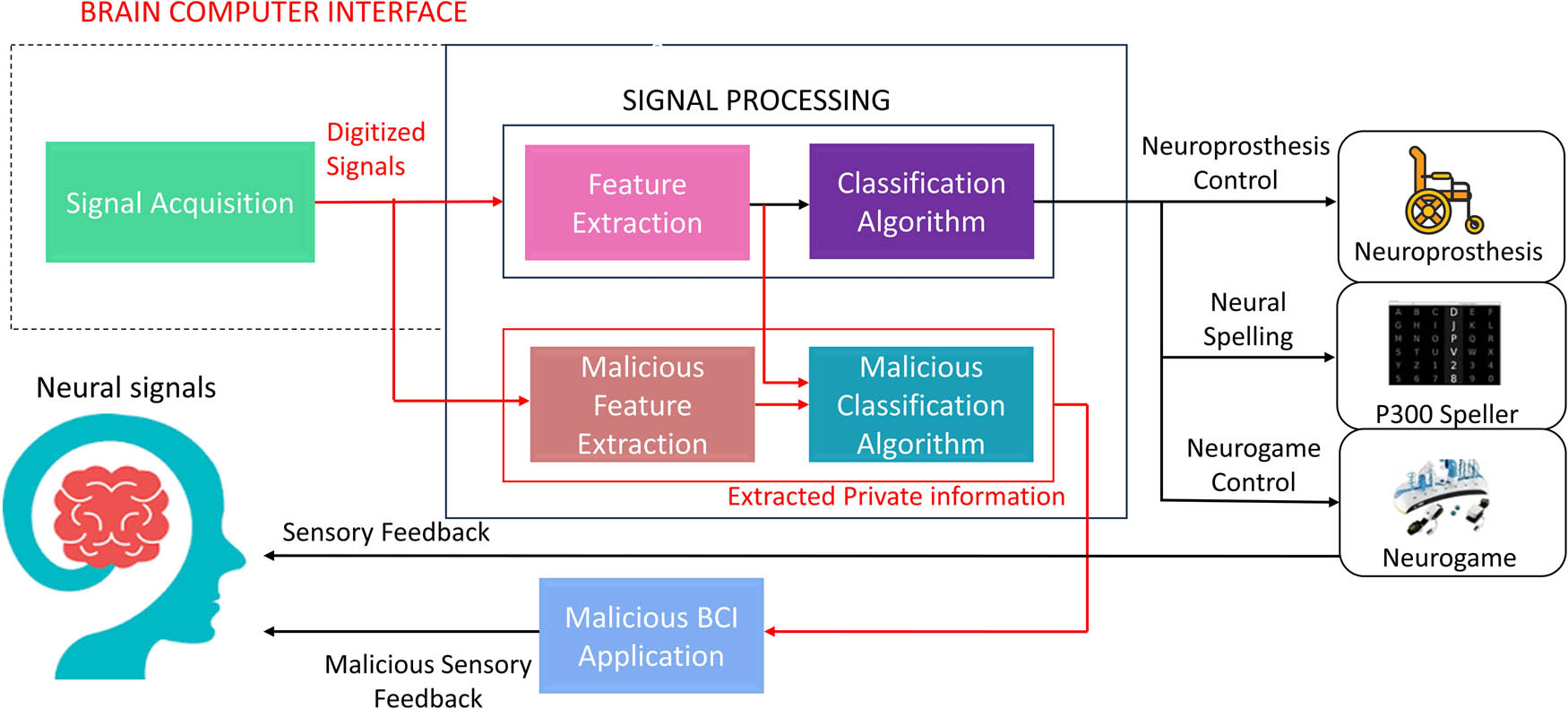
BCI with AI.
The following is the schematic diagram of the RL-based BCI.
RL [20] algorithms are crucial in brain-controlled interfaces, enabling seamless interaction between brain signals and external environments. They can be categorized into model-free and model-based approaches. Model-free RL learns from complex environment dynamics, while model-based RL builds a dynamics model, allowing agents to make informed decisions and maximize rewards. RL algorithms are crucial in closed-loop brain-controlled interfaces, translating neural signals into meaningful actions. These interfaces enable bidirectional communication between the brain and external devices, improving user experience and performance. RL-based interfaces have the potential for rehabilitation and motor function restoration in individuals with neurological disorders.
4.3.1 Power and limitations of model-free algorithms
While model-free deep RL algorithms can learn a large number of applications, they usually have a single job that they can only learn at a time and suffer from very high sample complexity, frequently requiring millions of samples to obtain decent performance.
4.3.2 Power and limitations of model-based algorithms
Model-oriented to create an internal model of the changes and immediate results in the environment, RL draws on experience. Next, using this world model as a guide, appropriate actions are selected by searching or organizing. Given that every bit of environmental information can be recorded in a manner that is both computationally manipulable and statistically accurate, experience can be used in a statistically efficient manner. Action selection can be easily adapted to changes in the transition circumstances and the outcomes’ utility, so long as continuous replanning is feasible. Goal-directed actions can be supported by model-based RL because of its flexibility.
4.3.3 Implementation of RL and BCI
Brain signals can be converted using the discrete Fourier transform from the time domain to the frequency domain. Alpha/mu waves (8–13 Hz), beta waves (14–30 Hz), gamma waves (>30 Hz), delta waves (0.5–3 Hz), and theta waves (4–7 Hz) are the several frequency bands into which brain impulses can be subdivided.
4.3.4 Filtering noise
High dimensionality, non-stationarity, noise, and complexity characterize the raw signals. Thus, several pre-processing stages must be completed by the signals beforehand. Following the signals’ pre-processing, features will be taken out and utilized to train a classifier, which will then assign classes to various feature sets that represent hypothetical human movement. One can reduce common noise and increase local activity by applying spatial filters such as the Laplacian filter or the common average reference. Deep sleep or unconsciousness is indicated by delta waves; deep sleep or alertness is indicated by theta waves; inactive wakefulness and relaxation are indicated by alpha waves; active wakefulness is indicated by beta waves; and intense attention and learning are indicated by gamma waves [21].
4.3.5 RL
To maximize a numerical long-term reward, an agent engages in interactions in uncertain surroundings through RL. Markov decision process is the term used to describe an RL problem satisfying the Markov property. It is feasible to forecast the next state using this attribute, without taking into account the past of all states and actions, based on the current state and action. The RL agent can determine which command to use in each state of the game thanks to the learnt policy.
These days, we can better understand and use brain activity to connect with computers and other devices thanks to neural interface technologies, different signal processing techniques, and recent advances in AI and RL. Here, we discussed the foundations of creating AI, RL, and BCI technologies along with the top 10 research projects and centers in this emerging field.
5 Application of brain cells and AI in healthcare
A revolutionary age in healthcare is being heralded by the merging of AI technology and brain cells, which holds the promise of ground-breaking improvements in personalized medicine, disease detection, treatment planning, and rehabilitation. Healthcare systems have the potential to transform patient treatment in a variety of medical specialties by combining the computational power of AI with a complex understanding of brain function. Here, we explore the various uses of AI and brain cells in healthcare and how these cutting-edge methods are changing the field of medicine [22]. Figure 6 illustrates some of the applications of BCI and AI in healthcare.
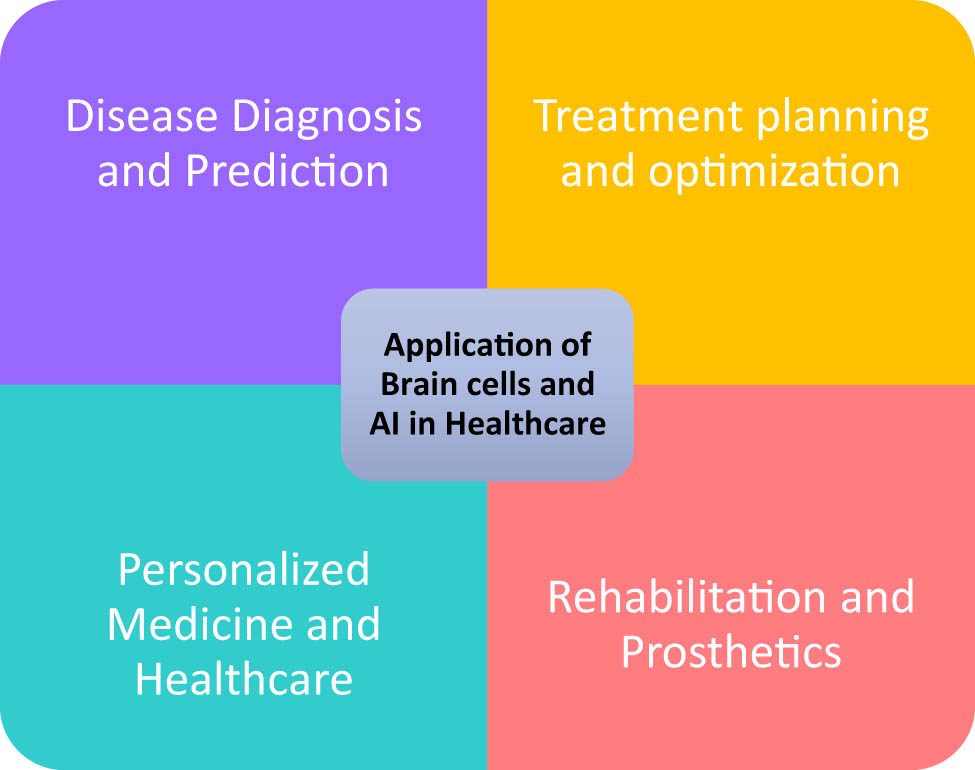
Application of brain cells and AI in healthcare.
5.1 Disease diagnosis and prediction
The combination of AI with brain cells transforms the diagnosis and prognosis of disease by using sophisticated computational algorithms to examine intricate biological data. AI algorithms analyzed multimodal data, such as neuroimaging scans, genetic data, and clinical assessments, in the context of neurological conditions like epilepsy, Parkinson’s disease, and Alzheimer’s disease to find patterns suggestive of the development, course, and prognosis of the condition. Early identification of illness biomarkers improves diagnostic accuracy and prompt therapies. This is made possible by machine learning and deep learning models trained on extensive datasets. Predictive analytics powered by AI also enables medical professionals to predict the course of diseases, recognize high-risk individuals, and take proactive steps to slow the spread of illnesses and enhance patient outcomes [23].
5.2 Treatment planning and optimization
By combining the capacity of brain cells and computational intelligence, AI-driven approaches to treatment planning and optimization enable the customization of therapeutic interventions and the optimization of treatment plans based on unique patient features. AI systems enable evidence-based decision-making and customized treatment plans that are suited to the individual needs of the patient by combining patient-specific data, such as genetic profiles, indicators, imaging results, and treatment histories. Treatment parameters can be changed in real-time via closed-loop brain-controlled interfaces using RL algorithms in response to dynamic changes in patient physiology and illness development. Furthermore, clinicians can anticipate difficulties and optimize treatment plans to maximize efficacy while minimizing side effects and complications by using predictive modeling techniques, which forecast treatment response and adverse events [24].
5.3 Personalized medicine and healthcare
Personalized medicine and healthcare efforts take advantage of the confluence of AI and brain cells to provide individualized therapies and interventions based on patient profiles. AI algorithms pick the best course of treatment and dose by identifying patient-specific biomarkers and therapeutic targets through the analysis of genomic data, molecular signatures, and clinical characteristics. Risk assessment and prognosis estimation are made possible by predictive modeling approaches, which give clinicians the ability to allocate resources and prioritize interventions effectively. Additionally, by combining complicated medical data and delivering individualized treatment suggestions based on each patient’s preferences, values, and health objectives, AI-driven decision support systems enable shared decision-making between patients and clinicians [25].
5.4 Rehabilitation and prosthetics
Enhancing the ability to move, restoring mobility, and improving the quality of life for people with neurological impairments or physical disabilities is made possible by the integration of brain cells with AI technology in rehabilitation and prosthetics [26]. With the use of BCIs, people can interact more independently and autonomously with their surroundings and carry out daily tasks. BCI converts neural signals from the brain into real-time control commands for external devices, such as robotic exoskeletons, prosthetic limbs, and assistive technologies. Through user input, adaptability to user preferences, and reduction of motor execution faults, RL methods maximize BCI performance. Additionally, AI-driven neurorehabilitation platforms enable motor learning, brain plasticity, and recovery from function following neurological injury or disease by providing personalized training plans and adaptive therapies catered to the specific needs of each patient.
These applications show how combining AI and brain cells can revolutionize healthcare by encouraging creativity, enhancing patient outcomes, and pushing the boundaries of medical research and technology.
6 Future directions in brain cells and AI integration
Future research on brain cells and the use of AI in healthcare offers revolutionary developments that will completely change how neurological illnesses are identified, treated, and managed. A change is apparent in the direction of increasingly advanced BCIs that can decode complicated neurological signals with never-before-seen accuracy and precision. Furthermore, the merging of multimodal data sources – such as neuroimaging, genetic, and physiological data – to generate thorough patient profiles for personalized medicine methods will be made possible by developments in neuroinformatic and computational neuroscience. Additionally, the integration of clinical workflows with AI-driven decision support systems will optimize treatment plans catered to the specific needs of each patient, enhance diagnostic precision, and expedite the delivery of healthcare. The future is full of opportunities to use brain cells and AI to gain new insights into brain function and disease mechanisms, which will ultimately improve patient outcomes and quality of care globally as interdisciplinary collaborations grow and technology advances.
7 Conclusion
In conclusion, the fusion of AI with brain cells offers a novel approach to healthcare that will undoubtedly improve patient outcomes, advance medical practice, and improve quality of life. The combination of AI and brain cells has allowed for incredible progress in personalized medicine, rehabilitation, disease diagnosis, and therapy optimization. This has completely changed the way that healthcare is delivered and researched. Researchers and doctors can discover more about brain function, neurological conditions, and human cognition by utilizing AI algorithms and BCIs. This will open the door to more creative and successful healthcare interventions. To secure the ethical and responsible integration of AI and brain cells in healthcare systems worldwide, we must prioritize interdisciplinary collaboration, patient-centric methods, and ethical considerations as we navigate the future of smart healthcare. By seizing the chances and obstacles posed by this revolutionary technology, we can expand our knowledge of the human brain, improve communication between humans and machines, and advance integrative methods for wellness and healthcare delivery.
-
Funding information: Authors state no funding involved.
-
Author contributions: All authors accepted the responsibility for the content of the manuscript and consentedto its submission, reviewed all the results, and approved the final version of the manuscript. OA – writing, diagram, and reference. ACh – proofreading and guidance.
-
Conflict of interest: Authors state no conflict of interest.
-
Informed consent: Informed consent has been obtained from all individuals included in this study.
-
Ethical approval: The research related to human use has been complied with all the relevant national regulations, institutional policies and has been approved by the authors’ institutional review. The research does not include anything related to animals. The conducted research is not related to animal use.
-
Data availability statement: Data sharing is not applicable to this article as no datasets were generated or analyzed during the current study.
References
[1] Ramadan RA, Altamimi AB. Unraveling the potential of brain-computer interface technology in medical diagnostics and rehabilitation: A comprehensive literature review. Health Technol. 2024 Feb;1:1–4.Search in Google Scholar
[2] Jaber W, Jaber HA, Jaber R, Saleh Z. The convergence of AI and BCIs: A new era of brain-machine interfaces. Artif Intell Age Nanotechnol. 2024;1:98–113.10.4018/979-8-3693-0368-9.ch006Search in Google Scholar
[3] Varone G, Boulila W, Driss M, Kumari S, Khan MK, Gadekallu TR, et al. Finger pinching and imagination classification: A fusion of CNN architectures for IoMT-enabled BCI applications. Inf Fusion. 2024 Jan;101:102006.10.1016/j.inffus.2023.102006Search in Google Scholar
[4] Karikari E, Koshechkin KA. Review on brain-computer interface technologies in healthcare. Biophys Rev. 2023;15(5):1351–8.10.1007/s12551-023-01138-6Search in Google Scholar PubMed PubMed Central
[5] Hong PJ, Asghar MA, Ullah A, Shorfuzzaman M, Masud M, Mehmood RM. AI-based Bayesian inference scheme to recognize electroencephalogram signals for smart healthcare. Clust Comput. 2023 Apr;26(2):1221–30.10.1007/s10586-022-03678-0Search in Google Scholar
[6] Blankertz B, Muller KR, Krusienski DJ, Schalk G, Wolpaw JR, Schlogl A, et al. The BCI competition III: Validating alternative approaches to actual BCI problems. IEEE Trans Neural Syst Rehabilitation Eng. 2006;14(2):153–9.10.1109/TNSRE.2006.875642Search in Google Scholar PubMed
[7] Parui S, Samanta D, Chakravorty N. An advanced healthcare system where internet of things meets brain-computer interface using event-related potential. In: Proceedings of the 24th International Conference on Distributed Computing and Networking; 2023 Jan 4. p. 438–43.10.1145/3571306.3571449Search in Google Scholar
[8] Pirasteh A, Shamseini Ghiyasvand M, Pouladian M. EEG-based brain-computer interface methods with the aim of rehabilitating advanced stage ALS patients. Disability Rehabil: Assistive Technol. 2024 Feb;1:1–11.10.1080/17483107.2024.2316312Search in Google Scholar PubMed
[9] Kumar Y, Kumar J, Sheoran P. Integration of cloud computing in BCI: A review. Biomed Signal Process Control. 2024;87:105548.10.1016/j.bspc.2023.105548Search in Google Scholar
[10] Meunier A, Žák MR, Munz L, Garkot S, Eder M, Xu J, et al. A Conversational Brain-Artificial Intelligence Interface. arXiv preprint arXiv:2402.15011; 2024 Feb.Search in Google Scholar
[11] Waghmare K, Malhotra M. Mental health disorder through electroencephalogram analysis using computational model. Handb AI-Based Model Healthc Med. 2024;207–25.Search in Google Scholar
[12] Oprea SV, Nica I, Bâra A, Georgescu IA. Are skepticism and moderation dominating attitudes toward AI‐based technologies? Am J Econ Sociol. 2024.10.1111/ajes.12565Search in Google Scholar
[13] Shin DH, Son YH, Kim JM, Ahn HJ, Seo JH, Ji CH, et al. MARS: Multiagent reinforcement learning for spatial–spectral and temporal feature selection in EEG-based BCI. IEEE Trans Syst Man Cybern: Systems. 2024 Feb;54(5):3084–96.10.1109/TSMC.2024.3355101Search in Google Scholar
[14] Waghmare K, Malhotra M. 12 mental disorder health through electroencephalogram analysis using computational model. Handb AI-Based Model Healthc Med: Approaches Theories Appl. 2024 Feb;207.10.1201/9781003363361-12Search in Google Scholar
[15] Kumar P, Javeed D, Kumar R, Islam AN. Blockchain and explainable AI for enhanced decision making in cyber threat detection. Software: Pract Exper. 2024.10.1002/spe.3319Search in Google Scholar
[16] Taha MA, Morren JA. The role of artificial intelligence in electrodiagnostic and neuromuscular medicine: Current state and future directions. Muscle Nerve. 2024 Mar;69(3):260–72.10.1002/mus.28023Search in Google Scholar PubMed
[17] Samal P, Hashmi MF. Role of machine learning and deep learning techniques in EEG-based BCI emotion recognition system: a review. Artif Intell Rev. 2024 Mar;57(3):1–66.10.1007/s10462-023-10690-2Search in Google Scholar
[18] Voigtlaender S, Pawelczyk J, Geiger M, Vaios EJ, Karschnia P, Cudkowicz M, et al. Artificial intelligence in neurology: opportunities, challenges, and policy implications. J Neurol. 2024 Feb;1:1–6.Search in Google Scholar
[19] Pancholi S, Everett IV TH, Duerstock BS. Advancing spinal cord injury care through non-invasive autonomic dysreflexia detection with AI. Sci Rep. 2024 Feb;14(1):3439.10.1038/s41598-024-53718-5Search in Google Scholar PubMed PubMed Central
[20] Naik R, Chaudhari K, Jadhav K, Joshi A, Decoding EEG. Signals to generate images using GANs. In Handbook of AI-Based Models in Healthcare and Medicine. Abingdon, Oxon: CRC Press; 2024. p. 190–206.10.1201/9781003363361-11Search in Google Scholar
[21] Sakthivel N, Florence ML. An exploration of human brain activity using BCI with EEG techniques. Int J Advanced Networking and Applications. 2023;15(4):100–200.Search in Google Scholar
[22] Gad AO. Brain-computer interface for supervisory controls of unmanned aerial vehicles (Doctoral dissertation). Purdue University Graduate School. 2024.Search in Google Scholar
[23] Bhidayasiri R. The grand challenge at the frontiers of neurotechnology and its emerging clinical applications. Front Neurol. 2024 Jan;15:1314477.10.3389/fneur.2024.1314477Search in Google Scholar PubMed PubMed Central
[24] Aluvalu R, Aravinda K, Maheswari VU, Kumar KA, Rao BV, Prasad KM. Designing a cognitive smart healthcare framework for seizure prediction using multimodal convolutional neural network. Cognit Neurodynamics. 2024;1:1–13.10.1007/s11571-023-10049-xSearch in Google Scholar
[25] Dabas S, Saxena P, Nordlund N, Ahamed SI. A step closer to becoming symbiotic with AI through EEG: A review of recent BCI technology. In: 2020 IEEE 44th Annual Computers, Software, and Applications Conference (COMPSAC). IEEE; 2020, July. p. 361–8.10.1109/COMPSAC48688.2020.0-220Search in Google Scholar
[26] Butt AM, Alsaffar H, Alshareef M, Qureshi KK. AI prediction of brain signals for human gait using BCI device and FBG based sensorial platform for plantar pressure measurements. Sensors. 2022;22(8):3085.10.3390/s22083085Search in Google Scholar PubMed PubMed Central
© 2024 the author(s), published by De Gruyter
This work is licensed under the Creative Commons Attribution 4.0 International License.
Articles in the same Issue
- Research Articles
- Predictors of diagnosed cardiovascular diseases and their spatial heterogeneity in Lagos State, Nigeria
- Discourses of risk in public health advertising about underage alcohol consumption
- Utilization of health service and associated factors among women in childbearing age in selected internally displaced persons camps, Hargeisa – Somaliland
- Healthcare workers’ attitudes toward children getting Covid-19 vaccinations in Gaza Strip
- Regional prevalence and spatial modeling of hypertension in South Africa
- Immediate effect of mud pack on resting cardiovascular parameters in hypertensive individuals – A single-arm pilot study
- An analysis of medical scheme-related pregnancy terminations in South Africa in 2022
- Immediate effect of Kaki Mudra on pupillary light reflex among healthy individuals – A study protocol of a Randomized control trial
- Healthy lifestyle perceptions and practices among college students at Yanbu University College for Women in Saudi Arabia
- Food service management perspectives on reducing sodium content in foods served: Opportunities and challenges
- Effects of sanitation on child growth in Serbian Roma communities
- College students’ resilience-promoting behaviors and psychological well-being: A latent class analysis
- Comparative analysis of household deprivation among Jewish and other religious groups in England and Wales
- A study protocol for a randomized controlled trial on the effect of Surya Nadi Pranayama practice on cognitive abilities in school children
- Determinants of health insurance adoption among residents of Lagos, Nigeria: A cross-sectional survey
- Enhancing geographical access to cardiovascular disease healthcare services in Lagos State, Nigeria
- Mortality trends from all causes and diabetes mellitus according to sex between 1998 and 2021
- Developing syndrome of inappropriate antidiuretic hormone secretion in Guillain-Barre syndrome
- Health professionals’ continuing education attitudes and experiences in food and nutrition sustainability
- Nutrition literacy among women participating in a community kitchen program in Antioquia, Colombia: A cross-sectional study
- Review Articles
- Unraveling PCOS: Exploring its causes and diagnostic challenges
- Smart healthcare: Integration of AI and brain cells for advanced healthcare applications
- Disrupting the melody: The interplay of obesity and metabolic dysfunction
- Comparing global trends in gastric cancer and the need for national screening programs: An in-depth literature review
- Social media – Boon or Bane?
- Advancing rheumatic disease treatment: A journey towards better lives
- Antimicrobial resistance: A significant public health issue of both human and veterinary concern
- Psychological flexibility and celiac disease in adolescents: Understanding adherence and well-being for enhanced care. A rapid narrative review
- Harnessing real-world evidence in pharmacoeconomics: A comprehensive review
- Commentary
- Mixed messages, broken trust, avoidable deaths: A critical appraisal of the UK government’s response to the COVID-19 pandemic
- The psychological profile of Iraq: A nation haunted by decades of suffering
- Metabolic mysteries of the mind: Investigating type 3 diabetes
- Ready to bleed when touched – Moral Injury in the Special Operations Forces military population
- Towards robust pharmacovigilance surveillance systems
- Short Communications
- From click to calories: Navigating the impact of food delivery apps on obesity
- Long-term economic outlook for Japan, as impacted by COVID-19
- Special Issue on Public Health Resilience - Part II
- Reframing the response to the opioid crisis: The critical role of resilience in public health
Articles in the same Issue
- Research Articles
- Predictors of diagnosed cardiovascular diseases and their spatial heterogeneity in Lagos State, Nigeria
- Discourses of risk in public health advertising about underage alcohol consumption
- Utilization of health service and associated factors among women in childbearing age in selected internally displaced persons camps, Hargeisa – Somaliland
- Healthcare workers’ attitudes toward children getting Covid-19 vaccinations in Gaza Strip
- Regional prevalence and spatial modeling of hypertension in South Africa
- Immediate effect of mud pack on resting cardiovascular parameters in hypertensive individuals – A single-arm pilot study
- An analysis of medical scheme-related pregnancy terminations in South Africa in 2022
- Immediate effect of Kaki Mudra on pupillary light reflex among healthy individuals – A study protocol of a Randomized control trial
- Healthy lifestyle perceptions and practices among college students at Yanbu University College for Women in Saudi Arabia
- Food service management perspectives on reducing sodium content in foods served: Opportunities and challenges
- Effects of sanitation on child growth in Serbian Roma communities
- College students’ resilience-promoting behaviors and psychological well-being: A latent class analysis
- Comparative analysis of household deprivation among Jewish and other religious groups in England and Wales
- A study protocol for a randomized controlled trial on the effect of Surya Nadi Pranayama practice on cognitive abilities in school children
- Determinants of health insurance adoption among residents of Lagos, Nigeria: A cross-sectional survey
- Enhancing geographical access to cardiovascular disease healthcare services in Lagos State, Nigeria
- Mortality trends from all causes and diabetes mellitus according to sex between 1998 and 2021
- Developing syndrome of inappropriate antidiuretic hormone secretion in Guillain-Barre syndrome
- Health professionals’ continuing education attitudes and experiences in food and nutrition sustainability
- Nutrition literacy among women participating in a community kitchen program in Antioquia, Colombia: A cross-sectional study
- Review Articles
- Unraveling PCOS: Exploring its causes and diagnostic challenges
- Smart healthcare: Integration of AI and brain cells for advanced healthcare applications
- Disrupting the melody: The interplay of obesity and metabolic dysfunction
- Comparing global trends in gastric cancer and the need for national screening programs: An in-depth literature review
- Social media – Boon or Bane?
- Advancing rheumatic disease treatment: A journey towards better lives
- Antimicrobial resistance: A significant public health issue of both human and veterinary concern
- Psychological flexibility and celiac disease in adolescents: Understanding adherence and well-being for enhanced care. A rapid narrative review
- Harnessing real-world evidence in pharmacoeconomics: A comprehensive review
- Commentary
- Mixed messages, broken trust, avoidable deaths: A critical appraisal of the UK government’s response to the COVID-19 pandemic
- The psychological profile of Iraq: A nation haunted by decades of suffering
- Metabolic mysteries of the mind: Investigating type 3 diabetes
- Ready to bleed when touched – Moral Injury in the Special Operations Forces military population
- Towards robust pharmacovigilance surveillance systems
- Short Communications
- From click to calories: Navigating the impact of food delivery apps on obesity
- Long-term economic outlook for Japan, as impacted by COVID-19
- Special Issue on Public Health Resilience - Part II
- Reframing the response to the opioid crisis: The critical role of resilience in public health

